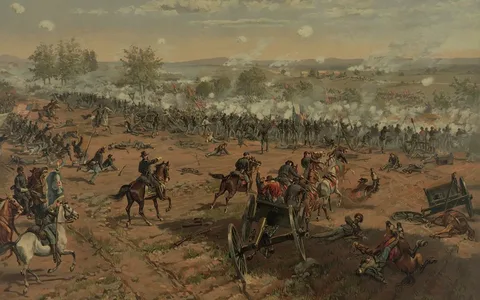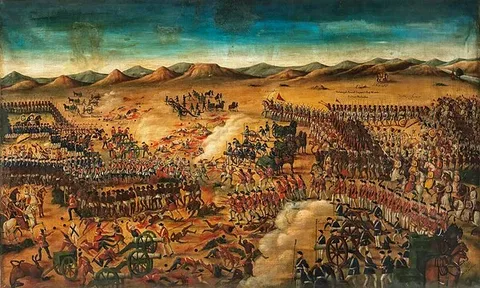Starting content compilation and structuring for “The Battle of Haneen (8 Hijri)” now, based on sourced information.The Battle of Haneen (8 Hijri) was a critical military engagement that took place shortly after the Islamic conquest of Mecca, occurring in the year 8 AH (630 CE). This battle was fought between the Muslim forces led by the Prophet Muhammad (peace be upon him) and a coalition of Bedouin tribes, primarily the Hawazin and Thaqif tribes. The confrontation took place in the valley of Hunayn, located on the route from Mecca to Taif. Despite initial setbacks and challenges, the battle concluded with a decisive Muslim victory, consolidating the political and military strength of the nascent Islamic state.
The Battle of Haneen
The victory of the Muslims in Mecca disrupted the traditional power balance in the Arabian Peninsula. The tribes of Hawazin and Thaqif, leaders in the region between Mecca and Taif, perceived the rising influence and expansion of Islam as a threat to their autonomy and prestige. Anticipating an attack after the conquest of Mecca, these tribes gathered a large coalition force to confront the Muslims proactively. Their intent was to challenge this growing force and halt the consolidation of Islamic authority in the region.
Military Strength and Preparation

The Islamic army consisted of approximately 12,000 soldiers, including many who had recently converted to Islam from Mecca. The opposing coalition force was made up of about 4,000 men from the Hawazin and Thaqif tribes and their allies. The enemy forces chose the narrow and rugged Hunayn valley strategically to launch a surprise ambush, exploiting its terrain to their advantage. Malik bin Awf, the commander of the opposing forces, ordered his men to hide in the valley and attack the Muslims with arrows and stones from concealed positions as they passed through, intending to create chaos and a rout.
Read more: The battle of Al-Hudaybeyah (6 Hijri)
The Battle Course
On the 10th of Shawwal, 8 AH, as the Muslim army entered the Hunayn valley, they were caught off guard by the fierce ambush from the enemy. The sudden barrage of arrows and the unexpected attack threw the Muslim ranks into disarray, causing a significant portion of the army to retreat in panic. The tight and confining nature of the valley contributed to the disorder.
However, a small, steadfast group including Ali ibn Abi Talib, Abbas ibn Abd al-Muttalib, and a few others remained to defend the Prophet. The Prophet Muhammad himself called upon the retreating Muslims to return, using loud calls to rally his forces. Gradually, hundreds rejoined the fight, inspired by the Prophet’s courage and leadership.
Ali ibn Abi Talib distinguished himself during the battle by courageously attacking the enemy’s standard-bearers, contributing significantly to turning the tide. Divine support is also mentioned in Islamic sources, with accounts of angels coming to aid the Muslims and a moment when the Prophet threw soil towards the enemy, further demoralizing them.
Outcome and Spoils
The battle culminated in a decisive Muslim victory. Approximately 70 enemy warriors were killed, while only four Muslims were martyred. The Muslim forces captured a vast amount of spoils, including approximately 24,000 camels, 4,000 sheep, and 4,000 silver plates. Additionally, around 6,000 women and children from the opposing tribes were taken as captives.
The Prophet Muhammad’s attitude towards the defeated enemy was notably merciful. Instead of imposing harsh punishments, he pardoned the captives and allowed many to return to their people with goodwill, leading to many of these tribes embracing Islam subsequently.
Read about: The battle of Domat-Ul-Gandal (5 Hijri)
Significance of the Battle of Haneen
The Battle of Haneen marked a crucial moment in early Islamic history. It tested the resolve and unity of the Muslim community just after their conquest of Mecca and demonstrated the importance of faith, leadership, and resilience in warfare. The victory consolidated Muslim control over the Hejaz region, diminished opposition from powerful tribes, and expanded Islam’s reach significantly.
It is also one of the few battles mentioned explicitly by name in the Qur’an (Surat At-Tawbah), underscoring its importance in the Muslim collective memory and narrative.
FAQs
When did the Battle of Haneen take place?
The battle occurred in the year 8 Hijri (630 CE), shortly after the conquest of Mecca.
Who were the main opposing forces in the battle?
The battle was fought between the Muslim army led by Prophet Muhammad and a coalition of Bedouin tribes, primarily the Hawazin and Thaqif tribes.
What was the outcome of the Battle of Haneen?
The Muslims won a decisive victory, capturing many spoils and taking thousands of captives, while suffering minimal casualties.
Why was the Battle of Haneen significant in Islamic history?
It consolidated Muslim control over the Hejaz region after the conquest of Mecca and demonstrated faith and resilience under adversity.
How did the Prophet Muhammad treat the defeated enemy after the battle?
He showed mercy by pardoning the captives and allowing many to return to their people, which led to further conversions to Islam.
Conclusion
The Battle of Haneen stands as a testament to the perseverance and faith of the early Muslim community under the leadership of the Prophet Muhammad. Despite facing a cunning ambush and initial setbacks, the Muslims’ steadfastness, strategic leadership, and divine assistance led to a resounding victory. This triumph affirmed the consolidation of Islamic power in Arabia and paved the way for the expansion of Islam beyond the peninsula. The merciful treatment of the defeated also reflected the ethical and humanitarian values emphasized throughout the Islamic tradition, turning former adversaries into allies and contributing to the rapid spread of Islam.

